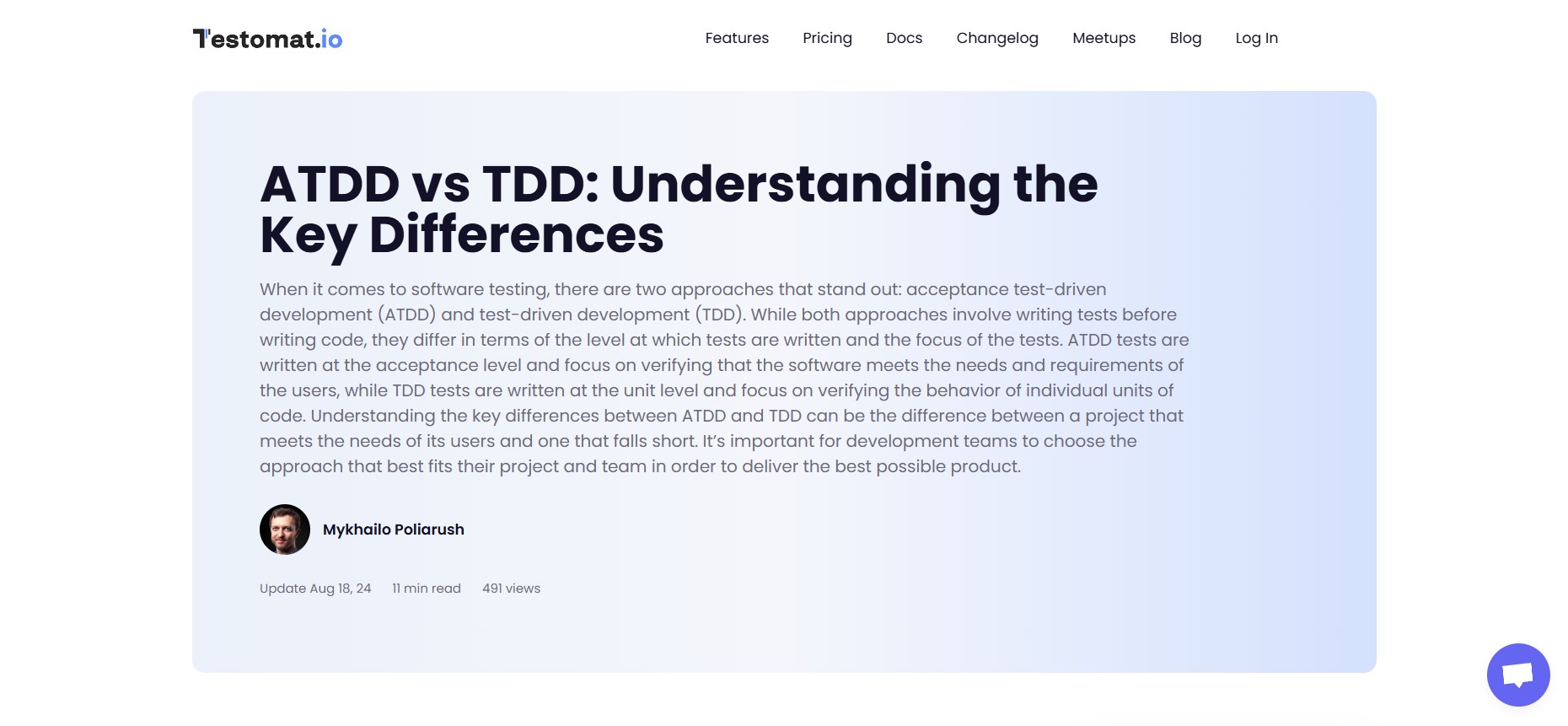ATDD vs TDD: Which Approach Fits Your Development Goals Best?

Strong 8k brings an ultra-HD IPTV experience to your living room and your pocket.
Understanding software development methodologies is crucial for ensuring that teams stay aligned, deliver reliable software, and reduce miscommunication between developers, testers, and business stakeholders. Among the various development strategies, Test-Driven Development (TDD) and Acceptance Test-Driven Development (ATDD) are often discussed and compared. While these methods share similarities, they serve different purposes and involve different stakeholders in the software development lifecycle. A closer look at these two techniques reveals critical distinctions and strategic implications for engineering teams aiming to optimize their development processes.
When discussing ATDD, it's important to start with a clear definition. ATDD stands for Acceptance Test-Driven Development, a practice that encourages collaboration among developers, testers, and business stakeholders before writing code. The goal of ATDD is to define acceptance criteria in the form of automated tests that describe the expected behavior of a system. These tests are created before the code is implemented and serve as a shared understanding of what the software should do.
In contrast, TDD focuses on writing unit tests for small pieces of code before actual implementation. The process begins with the developer writing a failing test, then writing the minimal code required to make that test pass, and finally refactoring the code while keeping the tests green. TDD is more concerned with internal software design and code correctness at the granular level, while ATDD is focused on validating business requirements and ensuring that the software behaves correctly from a user's perspective.
To understand when and why to use each method, it’s necessary to explore their processes, benefits, and best use cases.
### The Philosophy Behind TDD
TDD emerged as a way to guide software development through short, repeatable cycles. The three core steps of TDD are:
1. Write a failing test.
2. Write just enough code to pass the test.
3. Refactor the code while ensuring all tests still pass.
This methodology improves code quality, encourages modular design, and leads to better test coverage. TDD helps developers think about the design of their code from the outset, forcing them to consider edge cases and handle them proactively. However, TDD often operates in a developer-only silo, where tests are written primarily from a technical perspective, sometimes without considering the broader business context.
TDD can be incredibly effective for building complex systems with multiple layers and intricate interactions. However, because it focuses on the developer’s point of view, it may not always capture the real-world expectations of stakeholders or end users.
### The Business-Driven Nature of ATDD
**ATDD stands for** a methodology that brings together business analysts, developers, and testers to collaborate on defining the expected system behavior before coding begins. This shared conversation leads to the creation of acceptance tests, which are then automated and serve as a contract between stakeholders and the development team.
In this sense, ATDD acts as a communication bridge. Rather than interpreting business requirements individually, the entire team collectively agrees on the acceptance criteria. This approach minimizes misunderstandings, reduces rework, and ensures the delivered product meets business goals.
Unlike TDD, which uses unit tests, ATDD typically uses acceptance-level tests written in business-readable formats, such as Gherkin syntax used in BDD tools. These tests are expressed in Given-When-Then scenarios and validate the application’s behavior from the user’s standpoint.
One of the most compelling benefits of ATDD is that it shifts testing to the left—making it a proactive activity instead of a reactive one. By defining acceptance tests early, teams avoid the pitfall of late-stage requirement changes or misaligned features.
### Collaboration and Communication in ATDD
The core strength of ATDD lies in its emphasis on collaboration. Developers don’t work in isolation—they work closely with testers and business representatives to define what “done” means for each feature. This means that acceptance criteria are not just technical but aligned with actual business needs.
Imagine a scenario where a product manager wants a user registration feature that validates email addresses. In a traditional approach, the requirement might be loosely defined in a specification document. But with ATDD, the whole team discusses the expected behavior: what qualifies as a valid email, what error messages should appear, how the system handles edge cases like duplicate registrations, and so on. These discussions lead to test scenarios that developers then implement.
By using automated acceptance tests as living documentation, ATDD ensures that requirements are not only clearly understood but also verified throughout the lifecycle of the software.
### Comparing Test Scope: TDD vs ATDD
Another major difference between TDD and ATDD is the scope of the tests. TDD focuses on unit-level testing. Each test is typically aimed at a single method or function, ensuring that it performs correctly under various conditions. These tests provide fast feedback and help isolate bugs early in development.
ATDD tests are broader in scope. They evaluate entire features or user stories and check that the application behaves as expected from an external user’s perspective. These tests may involve multiple components, including the UI, backend logic, and database, depending on how the system is architected.
Because of their broader scope, ATDD tests tend to take longer to execute and may be more brittle due to dependencies across different layers of the system. However, they are invaluable for validating business workflows and ensuring end-to-end functionality.
### Real-World Benefits of ATDD
Implementing ATDD has several strategic advantages for software teams:
* Improved Requirement Clarity: Early collaboration clarifies acceptance criteria and reduces ambiguity.
* Reduced Defects: Since acceptance tests are written before development begins, teams are less likely to implement incorrect functionality.
* Better Stakeholder Confidence: Business stakeholders see their expectations turned into automated tests, which increases transparency and trust.
* Faster Feedback Loops: Automated acceptance tests provide instant feedback during development and regression testing.
* Documentation by Example: Acceptance tests serve as living documentation that reflects current system behavior.
Organizations that use ATDD report improved delivery timelines, better collaboration, and higher customer satisfaction.
### Combining ATDD and TDD
Although ATDD and TDD are often contrasted, they are not mutually exclusive. In fact, many high-performing teams use both. ATDD drives development at the feature level, ensuring the right features are built. TDD complements this by ensuring those features are implemented correctly at the code level.
Using both practices in tandem allows for a comprehensive testing strategy: ATDD ensures business alignment, while TDD guarantees technical correctness. This hybrid approach creates a robust safety net for the codebase and aligns technical implementation with business goals.
For instance, a team might begin by defining acceptance tests for a new feature using ATDD. Once those high-level scenarios are in place, developers write unit tests via TDD for the specific classes or methods required to pass the acceptance tests. As development progresses, both sets of tests evolve and provide continuous feedback.
### Challenges of Adopting ATDD
Despite its benefits, ATDD can be difficult to adopt in some environments. Teams unfamiliar with collaborative practices may struggle to align stakeholders early in the development process. Writing automated acceptance tests also requires tooling and infrastructure that not all teams possess.
Another hurdle is cultural. Developers and business stakeholders may have different expectations and communication styles. Bridging that gap takes time and patience. However, with consistent practice and support from leadership, organizations can embed ATDD into their development culture and reap its long-term rewards.
### Tooling to Support ATDD
Implementing ATDD effectively requires the right tooling. Tools like Testomat.io are designed to support collaborative test management and automated test execution. With capabilities like living documentation, test case synchronization, and integration with CI/CD pipelines, Testomat.io enables teams to implement ATDD practices at scale.
For teams looking to get started with or improve their ATDD practices, tools like these make it easier to create, maintain, and report on acceptance tests. They provide visibility across development and testing efforts and ensure that everyone—from developers to business analysts—can see what’s being tested and why.
To explore how ATDD fits into your development process and how tools can support it, read the full article:
[https://testomat.io/blog/atdd-vs-tdd-understanding-the-key-differences/](https://testomat.io/blog/atdd-vs-tdd-understanding-the-key-differences/)
You can also visit this link in anchor format: [**atdd stands for**](https://testomat.io/blog/atdd-vs-tdd-understanding-the-key-differences/)
### When to Use ATDD vs TDD
The decision to use ATDD, TDD, or both depends on the team’s goals, project scope, and organizational maturity.
* Use TDD when: You want to improve code quality, enforce modular design, and reduce bugs at the unit level.
* Use ATDD when: You need to align development with business goals, reduce miscommunication, and validate user-centric features.
* Use both when: You aim for a comprehensive development strategy that ensures both business and technical correctness.
Organizations building customer-facing applications, fintech systems, or complex enterprise platforms often find that combining ATDD and TDD yields the best results. ATDD ensures that the product solves the right problems, while TDD ensures that the solution is technically sound.
### Final Thoughts
Understanding what **ATDD stands for** goes beyond just decoding the acronym. It represents a cultural and technical shift in how teams build software—moving from siloed, reactive development to collaborative, behavior-driven design. By focusing on shared understanding, early testing, and business alignment, ATDD helps teams build the right features faster and with greater confidence.
While TDD is still essential for ensuring technical excellence, it doesn’t always address the gap between business expectations and technical execution. That’s where ATDD shines. By incorporating both approaches, teams can build software that is not only well-engineered but also aligned with real-world needs.
To dive deeper into the differences between ATDD and TDD, and explore real examples and use cases, visit:
[https://testomat.io/blog/atdd-vs-tdd-understanding-the-key-differences/](https://testomat.io/blog/atdd-vs-tdd-understanding-the-key-differences/)
Use this resource to evaluate how your team can benefit from these practices and what changes you may need to make to embrace a more collaborative and test-first development process.
Note: IndiBlogHub features both user-submitted and editorial content. We do not verify third-party contributions. Read our Disclaimer and Privacy Policyfor details.


